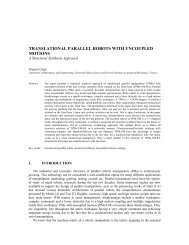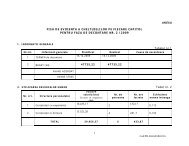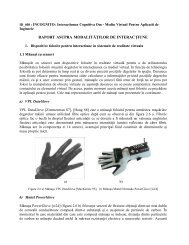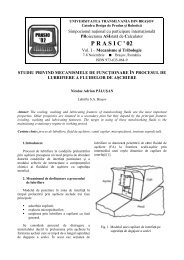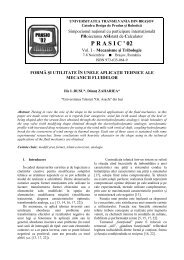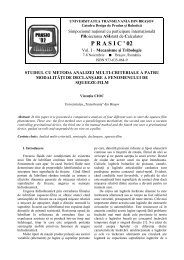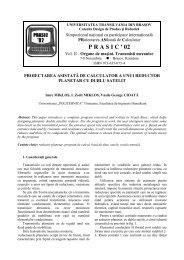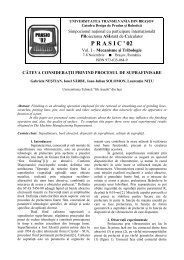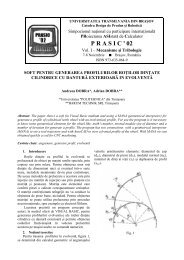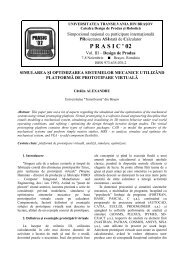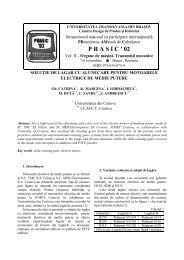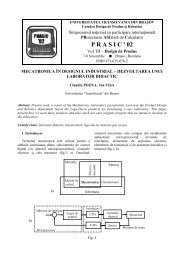real-time mbs formulations: towards virtual engineering
real-time mbs formulations: towards virtual engineering
real-time mbs formulations: towards virtual engineering
Create successful ePaper yourself
Turn your PDF publications into a flip-book with our unique Google optimized e-Paper software.
REAL-TIME MBS FORMULATIONS: TOWARDS VIRTUAL<br />
ENGINEERING<br />
J. Cuadrado, M. Gonzalez, R. Gutierrez, M.A. Naya<br />
Laboratory of Mechanical Engineering, University of La Coruña, Ferrol, Spain<br />
Abstract:<br />
This paper presents the research conducted during the last years by the Laboratory of Mechanical Engineering<br />
on <strong>real</strong>-<strong>time</strong> <strong>formulations</strong> for the dynamics of multi-body systems, a topic of great relevance for the<br />
development of new <strong>virtual</strong> <strong>real</strong>ity applications. The work carried out by our group has been focused on: a)<br />
the development of <strong>real</strong>-<strong>time</strong> <strong>formulations</strong> capable of performing very fast calculations of the dynamics of<br />
complex rigid-flexible multi-body systems; b) the experimental validation of the motions, deformations and<br />
forces obtained through the application of the abovementioned <strong>formulations</strong>, so as to verify that <strong>real</strong>ity is<br />
being reasonably well imitated; c) the study of the aptitude of such <strong>formulations</strong> for becoming part of a <strong>virtual</strong><br />
<strong>real</strong>ity environment, in connection with user-interface devices. In the paper, a <strong>real</strong>-<strong>time</strong> formulation developed<br />
by the authors is described, along with some examples of rigid-flexible multi-body systems simulated with<br />
such formulation. Moreover, results of the experimental validation of one of the examples are shown. Finally,<br />
a simulator based on the proposed formulation is presented.<br />
Key words: multi-body dynamics, <strong>real</strong>-<strong>time</strong> <strong>formulations</strong>, <strong>virtual</strong> <strong>real</strong>ity, product life-cycle, experimental validation,<br />
simulator.<br />
1. INTRODUCTION<br />
Entities in the <strong>real</strong> world can be considered from two points of view: graphical and physical. If a<br />
<strong>virtual</strong> environment is to be created in which just the graphical aspect of objects is accounted for, only<br />
the computer graphics discipline is needed. In such a <strong>virtual</strong> world, the user will be able to see, and<br />
perhaps to hear, but never to touch or to be touched. Although these capabilities can be enough for<br />
some applications, it is clear that they are far from replicating <strong>real</strong>ity. On the other hand, a <strong>virtual</strong><br />
environment can be conceived in which objects possess physical properties, besides the graphical<br />
ones, of course. Then, solids will experiment motion and/or deformation when forces act upon them,<br />
and the user will be allowed to interact with its environment and to feel through the sense of touch too.<br />
This <strong>virtual</strong> world is much closer to <strong>real</strong>ity than the previously described one.<br />
In order to develop environments with such types of capabilities, computational methods for the<br />
dynamics of rigid-flexible multi-body systems will be demanded which encompass the two following<br />
characteristics: a) adequate consideration of mechanical phenomena, like flexibility, contact, impact,<br />
friction, damping, etc.; b) very fast calculation of all the kinematic and dynamic magnitudes<br />
concerning the <strong>virtual</strong> bodies in the simulation and the user itself. Applications for physics-based<br />
<strong>virtual</strong> environments can be very diverse, but undoubtedly some of them are fully related to the<br />
product life-cycle: design (CAD), analysis (CAE), testing (CAT), manufacturing (CAM and CAPP),<br />
maintenance and end-of-the-product. More specifically, the practical implementation of some ecodesign<br />
concepts, like modularity, disassembling, reusability, recycling, new materials, low energy<br />
consumption, noise reduction, low cost, integration of intelligent systems, security, etc., can benefit<br />
from such applications.<br />
Having the mentioned objectives in mind, the work carried out by our group has been focused on:<br />
a) the development of <strong>real</strong>-<strong>time</strong> <strong>formulations</strong> capable of performing very fast calculations of the
170 J. Cuadrado, M. Gonzalez, R. Gutierrez, M.A. Naya<br />
dynamics of complex rigid-flexible multi-body systems; b) the experimental validation of the motions,<br />
deformations and forces obtained through the application of the abovementioned <strong>formulations</strong>, so as to<br />
verify that <strong>real</strong>ity is being reasonably well imitated; c) the study of the aptitude of such <strong>formulations</strong><br />
for becoming part of a <strong>virtual</strong> <strong>real</strong>ity environment, in connection with user-interface devices.<br />
The paper has been organized as follows: Section 2 describes a <strong>real</strong>-<strong>time</strong> formulation developed by<br />
the authors for the dynamics of rigid-flexible multi-body systems; Section 3 shows some examples of<br />
rigid-flexible multi-body systems simulated with such formulation, paying attention to the achieved<br />
efficiency, robustness and accuracy; Section 4 reports the results of the experimental validation of one<br />
of the examples; Section 5 presents a simulator based on the proposed formulation; and, finally,<br />
Section 6 summarizes the conclusions of the work.<br />
2. THE REAL-TIME FORMULATION<br />
The three main elements (modeling, dynamic equations and numerical integrator) of the proposed<br />
approach to solve the dynamics of rigid-flexible multi-body systems are described in what follows.<br />
For the modeling, fully-Cartesian coordinates, also known as natural coordinates, are used. Both rigid<br />
and flexible links are modeled with this type of coordinates in a total compatible form. Further<br />
explanation about these coordinates can be found in [1]. The dynamic equations are stated through an<br />
improved version of the index-3 augmented Lagrangian formulation with mass-orthogonal projections<br />
given in [2]. For the integration scheme, the unconditionally-stable implicit single-step trapezoidal rule<br />
has been chosen [3].<br />
2.1 Modeling<br />
The modeling of rigid bodies follows the general rules given in [1], and won’t be described here,<br />
since it can be considered as a well established technique.<br />
The modeling of flexible bodies is carried out by a floating frame of reference approach with<br />
component mode synthesis for small elastic displacements. The global motion of each flexible body is<br />
described as a superposition of the large-amplitude motion of a moving frame, rigidly attached to a<br />
certain point of the body, and the small elastic displacements of the body with respect to an<br />
undeformed configuration, taken as reference. Any deformed configuration of the body is expressed as<br />
a linear combination of static and dynamic modes, in the sense of the mode synthesis approach with<br />
fixed boundaries. The static modes depend on the natural coordinates defined at the joints of the body,<br />
while the number of internal, dynamic modes should be decided by the analyst. A detailed description<br />
of the kinematics of this method can be found in [4].<br />
However, the approach proposed in the abovementioned reference for the dynamics has not been<br />
adopted, as long as it showed to be too involved, particularly in what refers to the form of the inertia<br />
terms. Therefore, the co-rotational approximation suggested in [5] has been considered in the way<br />
proposed by [6] when natural coordinates are used for the modeling. This modified approach provides<br />
the same level of accuracy while notably simplifying the formulation of the mass matrix and velocity<br />
dependent forces vector. In what follows, the approach is<br />
briefly described.<br />
Figure 1 shows a general flexible body. Point r o<br />
and<br />
orthogonal unit vectors a, b and c serve to define the body<br />
local reference frame, and are always needed, so that they<br />
must compulsorily be considered as problem variables.<br />
Additional points and unit vectors (further problem<br />
variables) may be defined at the joints of the body (they<br />
will produce the static modes) in the typical way featured<br />
by the natural coordinates. The position of any point of the<br />
Figure 1. General flexible body.<br />
body can then be expressed as
Real-<strong>time</strong> MBS <strong>formulations</strong>: <strong>towards</strong> <strong>virtual</strong> <strong>engineering</strong> 171<br />
r= r + A( r + u ), (1)<br />
o<br />
u<br />
where r<br />
o<br />
is the position of the origin of the local reference frame, A the rotation matrix which<br />
columns are the three orthogonal unit vectors a, b and c already mentioned, r u<br />
the position of the<br />
point in local coordinates for the undeformed configuration of the body, and u the elastic<br />
displacement suffered by the point, also expressed in local coordinates. If the finite element method is<br />
used, the elastic displacement can be written as<br />
*<br />
u = Nu , (2)<br />
where N stands for the interpolation matrix which contains the interpolation functions, and<br />
elastic displacements of the nodes. Substituting Eq. (2) into Eq. (1) yields<br />
*<br />
u are the<br />
*<br />
r = r + A(<br />
r + Nu<br />
) . (3)<br />
o<br />
u<br />
At this point, the approach called co-rotational [5] is introduced. It implies the following<br />
interpolation for the velocity of any point of the flexible body<br />
*<br />
r & = Nv , (4)<br />
*<br />
where v are the velocities of the nodes. Obviously, expression given by Eq. (4) for the velocities is<br />
not consistent with expression given by Eq. (3) for the positions, as long as the former should be the<br />
derivative of the latter.<br />
Based on Eq. (4), the kinetic energy of the flexible body can be written in the form<br />
1 1<br />
T =<br />
2<br />
∫<br />
&dm ∫<br />
1<br />
T<br />
* T T *<br />
* T<br />
*<br />
r & r = v N Nv dm = v M<br />
FEMv<br />
, (5)<br />
2<br />
2<br />
v<br />
v<br />
where M<br />
FEM<br />
is the mass matrix of the finite element method. In order to express the kinetic energy in<br />
terms of the problem variables, velocities of the nodes, v * , should be related with the problem<br />
variables. Differentiating Eq. (3) and evaluating the result at the nodes gives<br />
v<br />
*<br />
& & +<br />
&<br />
* *<br />
= ro<br />
+ A( ru<br />
+ u ) Au<br />
(6)<br />
and considering that unit vectors a, b and c are the columns of rotation matrix A,<br />
⎧ r&<br />
o ⎫<br />
⎪ ⎪<br />
⎪<br />
a&<br />
⎪<br />
⎧ v ⎫ ⎡I<br />
a I a I a I A<br />
0 ⎤⎪<br />
b&<br />
⎪<br />
1<br />
11 12 13<br />
L L L<br />
⎪ ⎪ ⎢<br />
⎥⎪<br />
⎪<br />
⎢<br />
⎥⎪<br />
⎪<br />
⎪<br />
M<br />
⎪<br />
M<br />
M<br />
M c&<br />
*<br />
⎢<br />
⎥<br />
v = ⎨ ⎬ =<br />
⎨u<br />
&<br />
, (7)<br />
M M<br />
M<br />
M<br />
1 ⎬<br />
⎪ ⎪ ⎢<br />
⎥<br />
M<br />
⎪ ⎪<br />
⎪ ⎪ ⎢M<br />
M<br />
M ⎥ M<br />
⎪ ⎪<br />
⎪ ⎪ ⎢<br />
⎥<br />
⎩v<br />
p ⎭ ⎣I<br />
a<br />
p1I<br />
a<br />
p2I<br />
a<br />
p3I<br />
0 L L L A⎦⎪<br />
M ⎪<br />
⎪<br />
M<br />
⎪<br />
⎪ ⎪<br />
⎪<br />
⎩u<br />
&<br />
p<br />
⎪<br />
⎭<br />
where p is the number of nodes of the body, I the 3 by 3 identity matrix, and
172 J. Cuadrado, M. Gonzalez, R. Gutierrez, M.A. Naya<br />
a<br />
11<br />
= r ux 1<br />
+ u<br />
x1<br />
; a<br />
12<br />
= r uy 1<br />
+ u<br />
y1<br />
; a<br />
13<br />
= r uz 1<br />
+ u<br />
z1<br />
,<br />
a = r + u<br />
a = r + u<br />
p1 uxp xp<br />
;<br />
p2 uyp yp<br />
;<br />
p uzp zp<br />
a<br />
3<br />
= r + u . (8)<br />
The elastic displacements can be expressed as superposition of static and dynamic modes,<br />
ns<br />
∑<br />
i=<br />
1<br />
i<br />
i<br />
nd<br />
∑<br />
*<br />
u = Ω η + Ψ ξ , (9)<br />
j=<br />
1<br />
j<br />
j<br />
where n s and n d are the number of static and dynamic modes respectively, Ω<br />
i<br />
are the static modes, η i<br />
are their amplitudes, Ψ<br />
j<br />
are the dynamic modes, and ξ j<br />
are their amplitudes. Either the amplitudes of<br />
the static modes as well as those of the dynamic modes are considered as problem variables.<br />
Therefore, the problem variables for a general flexible body when using the proposed modeling<br />
technique are: the origin of the local reference frame, r<br />
o<br />
, the thee orthogonal unit vectors, a, b, and c,<br />
which define de local axes, and the amplitudes of static and dynamic modes, η i<br />
and ξ j<br />
, respectively.<br />
Substituting Eq. (9) into Eq. (7) leads to<br />
v<br />
*<br />
⎡I<br />
⎢<br />
⎢M<br />
= ⎢M<br />
⎢<br />
⎢M<br />
⎢<br />
⎣<br />
I<br />
b<br />
b<br />
11<br />
I<br />
p1<br />
I<br />
b<br />
b<br />
12<br />
I<br />
p2<br />
I<br />
b<br />
b<br />
13<br />
I<br />
p3<br />
I<br />
AΩ<br />
M<br />
M<br />
M<br />
AΩ<br />
1<br />
1<br />
p<br />
1<br />
...<br />
...<br />
AΩ<br />
M<br />
M<br />
M<br />
AΩ<br />
1<br />
ns<br />
p<br />
ns<br />
AΨ<br />
AΨ<br />
1<br />
1<br />
p<br />
1<br />
...<br />
...<br />
AΨ<br />
M<br />
M<br />
M<br />
AΨ<br />
1<br />
nd<br />
p<br />
nd<br />
⎧ r&<br />
0 ⎫<br />
⎪<br />
a&<br />
⎪<br />
⎪ ⎪<br />
⎪ b&<br />
⎪<br />
⎤⎪<br />
⎪<br />
⎥⎪<br />
c&<br />
⎪<br />
⎥<br />
⎪ & η<br />
⎪<br />
1<br />
⎥⎨<br />
⎬ = Bq&<br />
, (10)<br />
⎥⎪<br />
M<br />
⎪<br />
⎥⎪<br />
& η ⎪<br />
⎥<br />
ns<br />
⎦⎪<br />
& ⎪<br />
⎪ ξ1<br />
⎪<br />
⎪ M ⎪<br />
⎪<br />
&<br />
⎪<br />
⎪⎩<br />
ξn<br />
⎪<br />
d ⎭<br />
r<br />
where Ω<br />
i<br />
is a 3 by 1 vector containing static mode i evaluated at node r,<br />
containing dynamic mode j evaluated at node s, and<br />
s<br />
Ψ<br />
j<br />
is a 3 by 1 vector<br />
b<br />
ns<br />
nd<br />
ns<br />
nd<br />
11<br />
= rux<br />
1<br />
+ ∑ Ωix<br />
1η<br />
i<br />
+ ∑Ψ<br />
jx1ξ<br />
j<br />
; bp<br />
1<br />
= ruxp<br />
+ ∑ Ωixpηi<br />
+ ∑Ψ<br />
jxpξ<br />
j<br />
,<br />
i=<br />
1<br />
j=<br />
1<br />
i=<br />
1<br />
j=<br />
1<br />
b<br />
ns<br />
nd<br />
ns<br />
nd<br />
12<br />
= ruy1<br />
+ ∑ Ωiy1η<br />
i<br />
+ ∑Ψ<br />
jy1ξ<br />
j<br />
; bp2 = ruyp<br />
+ ∑ Ωiypηi<br />
+ ∑Ψ<br />
jypξ<br />
j<br />
,<br />
i=<br />
1<br />
j=<br />
1<br />
i=<br />
1<br />
j=<br />
1<br />
b<br />
= r<br />
+<br />
ns<br />
∑<br />
Ω<br />
η +<br />
nd<br />
∑<br />
Ψ<br />
ξ<br />
13 uz1<br />
iz1<br />
i<br />
jz1<br />
j<br />
;<br />
p uzp<br />
izp i<br />
jzp j<br />
i=<br />
1<br />
j=<br />
1<br />
i=<br />
1<br />
j=<br />
1<br />
ns<br />
∑<br />
nd<br />
∑<br />
b<br />
3<br />
= r + Ω η + Ψ ξ . (11)<br />
The vector appearing in the right-hand-side of Eq. (10), q& , is the vector of the derivatives<br />
*<br />
(velocities) of the body variables q, and then, substituting the value of v given by this equation into<br />
Eq. (5), the kinetic energy of the body can be written as
Real-<strong>time</strong> MBS <strong>formulations</strong>: <strong>towards</strong> <strong>virtual</strong> <strong>engineering</strong> 173<br />
1 T T 1 T<br />
T = q & B M Bq&<br />
q&<br />
Mq&<br />
FEM<br />
= , (12)<br />
2<br />
2<br />
which means that the mass matrix of the general flexible body is given by the expression<br />
T<br />
M = B M B . (13)<br />
FEM<br />
Application of Lagrange equations with the kinetic energy of the flexible body given by Eq. (12)<br />
leads to calculate the vector of velocity dependent inertia forces<br />
Q v<br />
T<br />
= −B<br />
M Bq & & . (14)<br />
FEM<br />
Therefore, it can be seen that, unlike their predecessors in [4], the final expressions for the inertia<br />
terms obtained through the abovementioned approach, given by Eqs. (13) and (14), are compact and<br />
relatively easy to evaluate.<br />
2.2 Dynamic equations and numerical integrator<br />
Once the modeling of a general flexible body has been explained, the approach to formulate the<br />
dynamic equations of the whole multi-body system as well as the numerical procedure to integrate<br />
them along the <strong>time</strong> is now addressed. Note that, as previously mentioned, either rigid and flexible<br />
links can be combined in a totally compatible form when using the proposed formulation, so that the<br />
actual mechanism can present both types of bodies.<br />
The equations of motion of the whole multi-body system are given by an index-3 augmented<br />
Lagrangian formulation in the form<br />
T *<br />
Mq& + Φ T<br />
αΦ<br />
+ Φ λ Q , (15)<br />
q q<br />
=<br />
where M is the mass matrix, q& & are the accelerations, Φ<br />
q<br />
the Jacobian matrix of the constraint<br />
*<br />
equations, α the penalty factor, Φ the constraints vector, λ the Lagrange multipliers and Q the vector<br />
of applied and velocity dependent inertia forces. The main sources of the constraints, grouped into<br />
vector Φ, are: the rigid body conditions among the variables of each rigid body; the rigid body<br />
conditions among the variables of the local reference frame of each flexible body, and among such<br />
variables and those defining static modes whose deformation is to be neglected; the relative motion<br />
conditions imposed by each joint among the variables of the two neighbor bodies connected by such<br />
joint. The Lagrange multipliers are obtained from the following iteration process (given by sub-index<br />
i, while sub-index n stands for <strong>time</strong>-step),<br />
λ α , i=0,1,2,..., (16)<br />
* *<br />
i+ 1<br />
= λ<br />
i<br />
+ Φi+<br />
1<br />
*<br />
*<br />
where the value of λ<br />
o<br />
is taken equal to the λ obtained in the previous <strong>time</strong>-step.<br />
As integration scheme, the implicit single-step trapezoidal rule has been adopted. The<br />
corresponding difference equations in velocities and accelerations are:<br />
2<br />
q<br />
n<br />
q<br />
n<br />
qˆ<br />
⎛ ⎞<br />
& &<br />
+ 1<br />
=<br />
+ 1<br />
+<br />
n<br />
with q & ˆ 2<br />
n<br />
= −⎜<br />
q<br />
n<br />
+ q&<br />
n ⎟ , (17)<br />
∆t<br />
⎝ ∆t ⎠<br />
4<br />
q& n<br />
q<br />
n<br />
q&<br />
ˆ<br />
⎛<br />
⎞<br />
+ 1<br />
=<br />
2 + 1<br />
+<br />
n<br />
with q && ˆ 4 4<br />
n<br />
= −⎜<br />
q<br />
n<br />
+ q&<br />
n<br />
+ q&<br />
n ⎟ . (18)<br />
2<br />
∆t<br />
⎝ ∆t ∆t ⎠
174 J. Cuadrado, M. Gonzalez, R. Gutierrez, M.A. Naya<br />
Dynamic equilibrium can be established at <strong>time</strong>-step n+1 by introducing the difference equations<br />
(17) and (18) into the equations of motion (15), leading to<br />
4<br />
∆t<br />
( Φ + λ ) − Q + Mq&<br />
ˆ 0<br />
T<br />
2 n+ 1<br />
+ Φ<br />
1 + 1 + 1 + 1<br />
=<br />
n+<br />
n n n<br />
n<br />
Mq &<br />
q<br />
α . (19)<br />
For numerical reasons, the scaling of Eq. (19) by a factor of ∆t 2 /4 seems to be convenient, thus<br />
yielding<br />
2<br />
2<br />
2<br />
∆t T<br />
∆t ∆t<br />
Mq ( ) ˆ<br />
n+ 1<br />
+ Φq α Φ<br />
1<br />
+<br />
1<br />
−<br />
1<br />
+ = 0<br />
n+<br />
1 n+<br />
λ<br />
n+<br />
Q<br />
n+<br />
Mq&<br />
n<br />
, (20)<br />
4<br />
4 4<br />
or, symbolically f ( q n+1<br />
) = 0 .<br />
In order to obtain the solution of this nonlinear system, the widely used iterative Newton-Raphson<br />
method may be applied<br />
( q)<br />
⎡∂f<br />
⎢<br />
⎣ ∂q<br />
⎤<br />
⎥ ∆q<br />
⎦<br />
i<br />
i +1<br />
= −<br />
being the residual vector<br />
[ f ( q)<br />
] i<br />
, (21)<br />
2<br />
∆t<br />
T<br />
T *<br />
[ f ( q)<br />
] = ( Mq&&<br />
+ Φ αΦ<br />
+ Φ λ − Q)<br />
4<br />
q<br />
q<br />
(22)<br />
and the approximated tangent matrix<br />
⎡∂f<br />
⎢<br />
⎣ ∂q<br />
2<br />
( q) ⎤ ∆t ∆t T<br />
= M + C + ( Φ αΦ<br />
K)<br />
⎥<br />
⎦<br />
2<br />
4<br />
q q<br />
+<br />
, (23)<br />
where C and K represent the contribution of damping and elastic forces of the system provided they<br />
exist.<br />
A closer look at the tangent matrix reveals that ill-conditioning may appear when the <strong>time</strong>-step<br />
becomes small. It may be seen in Eq. (23) that K and the constraint terms are multiplied by ∆t 2 , C by<br />
∆t and M is not affected by the step size. As a consequence when ∆t reaches small values, large roundoff<br />
errors will occur. In fact, it has been demonstrated in [7] that for an index-3 differential-algebraic<br />
equation, the tangent matrix has a condition number of order 1/∆t 3 . Consequently, the method is<br />
bound to have round-off errors for step sizes smaller than 10 -5 , which lets a sufficient range for<br />
solving practical problems.<br />
The procedure explained above yields a set of positions q<br />
n+ 1 that not only satisfies the equations<br />
of motion (19), but also the constraint condition Φ = 0 . However, it is not expected that the<br />
corresponding sets of velocities and accelerations satisfy Φ & = 0 and Φ &<br />
= 0 , because these conditions<br />
have not been imposed in the solution process. To overcome this difficulty, mass-damping-stiffnessorthogonal<br />
projections in velocities and accelerations are performed. It can be seen that the projections<br />
leading matrix is the same tangent matrix appearing in Eq. (23). Therefore, triangularization is avoided<br />
and projections in velocities and accelerations are carried out with just forward reductions and back<br />
substitutions.<br />
*<br />
If q& and q& & * are the velocities and accelerations obtained after convergence has been achieved in<br />
the Newton-Raphson iteration, their cleaned counterparts q& and q& & are calculated from
Real-<strong>time</strong> MBS <strong>formulations</strong>: <strong>towards</strong> <strong>virtual</strong> <strong>engineering</strong> 175<br />
2<br />
2<br />
2<br />
∆t<br />
∆t<br />
T<br />
∆t<br />
∆t<br />
* ∆t<br />
T<br />
[ M + C + ( Φ<br />
qαΦ<br />
q<br />
+ K)]<br />
q& = [ M + C + K]<br />
q&<br />
− Φ<br />
qαΦ<br />
t<br />
, (24)<br />
2 4<br />
2 4 4<br />
for the velocities, and<br />
2<br />
2<br />
2<br />
∆t<br />
∆t<br />
T<br />
∆t<br />
∆t<br />
* ∆t<br />
T<br />
[ M + C + ( Φ<br />
qα Φ<br />
q<br />
+ K)]<br />
q&<br />
= [ M + C + K]<br />
q&&<br />
− Φ<br />
qα(<br />
Φ&<br />
qq&<br />
+ Φ&<br />
t<br />
) , (25)<br />
2 4<br />
2 4 4<br />
for the accelerations.<br />
Sparse matrix technology can be implemented to solve all the linear sets of equations that arise<br />
when applying this method, provided the size of the system is large enough for such technique to be<br />
worthwhile. The fact that the leading matrix is symmetric and positive-definite can be taken into<br />
T<br />
T<br />
account as well. The products B M<br />
FEMB<br />
and B M B&<br />
q&<br />
FEM<br />
for each flexible body and ΦqΦ<br />
T<br />
q<br />
for<br />
the whole system, can also be optimized by considering the sparse character of the matrices.<br />
3. EXAMPLES<br />
In order to show the behavior of the described formulation, the following examples of rigid and<br />
flexible multi-body systems have been solved. In all cases, the simulations have been run on common<br />
personal computers. Based on the obtained results, the performance of the method is evaluated in<br />
terms of efficiency, robustness and accuracy.<br />
3.1 Double four-bar planar mechanism<br />
The first example is a one degree-of-freedom assembly<br />
of two four-bar linkages, illustrated in Figure 2, which has<br />
been proposed [8] as an example to test the performance in<br />
cases where the mechanism undergoes singular<br />
configurations. When the mechanism reaches a horizontal<br />
position, the number of degrees of freedom instantaneously<br />
increases from 1 to 3. All the links have a uniformly<br />
distributed unit mass and a unit length. The gravity force Figure 2. Double four-bar mechanism<br />
acts in the negative vertical direction. At the beginning, the<br />
links pinned to the ground are in vertical position and upwards, receiving a unit clockwise angular<br />
velocity. The simulation lasts for 10 s, during which the mechanism goes through the singular position<br />
ten <strong>time</strong>s..<br />
Table 1 shows the obtained results for different <strong>time</strong>-steps (∆t). The error is measured as the<br />
maximum deviation, in J, suffered by the system energy.<br />
Table 1. Error and CPU-<strong>time</strong> for the double four-bar mechanism.<br />
∆t (s) Error (J) CPU-<strong>time</strong> (s)<br />
0.01 -0.21 0.86<br />
0.03 -0.83 0.37<br />
0.05 -9.03 0.26<br />
0.1 wrong results wrong results<br />
As it can be seen in Table 1, the formulation shows a robust behavior when facing singular<br />
configurations, and large <strong>time</strong>-steps can be taken with acceptable accuracy. Regarding the efficiency,<br />
the example has been implemented in the computing environment Matlab. Although <strong>real</strong>-<strong>time</strong><br />
performance is achieved, the reported CPU-<strong>time</strong>s would be drastically reduced if the same programs<br />
were written in Fortran or C languages.
176 J. Cuadrado, M. Gonzalez, R. Gutierrez, M.A. Naya<br />
3.2 Serial robot<br />
The PUMA robot, designed by Unimation & Co. and shown in Figure 3, is an example of a 6<br />
degrees-of-freedom serial manipulator. It has been often used by different authors [9] to illustrate<br />
methods and procedures in several areas of robotics. In this work, the robot has been taken as an<br />
example of multibody system undergoing changing configurations.<br />
Starting from rest, torques at the six hinges of the robot are provided so that, in a <strong>time</strong> of 2 s, it<br />
arrives at a new position in the space, again in rest conditions. Once<br />
the new position has been reached, a point of the hand is attached to<br />
the ground, so that the robot loses 3 degrees-of-freedom. In this<br />
new configuration, torques are applied to the three rotational pairs<br />
of the hand, and a second maneuver, which lasts 4 s and ends with<br />
rest conditions, is performed. Finally, the robot is released from its<br />
attachment and returned in 2 s to the initial position by torques<br />
acting at the six revolute joints, once more finishing the maneuver<br />
at rest conditions. Therefore, the total simulation <strong>time</strong> is 8 s.<br />
Table 2 illustrates the results obtained when applying the<br />
proposed method. The error has been calculated as the distance, in<br />
Figure 3. PUMA robot<br />
mm, between the hand positions at initial and final <strong>time</strong>s (which,<br />
ideally, should be coincident).<br />
Table 2. Error and CPU-<strong>time</strong> for the PUMA robot.<br />
∆t (s) Error (mm) CPU-<strong>time</strong> (s)<br />
0.01 0.53 6.25<br />
0.05 3.4 1.92<br />
0.1 no convergence no convergence<br />
From the results reported in Table 2, it is obvious that the formulation deals well with changing<br />
configurations. As in the previous example, large <strong>time</strong>-steps can be taken with acceptable accuracy.<br />
Although the example has been implemented in the computing environment Matlab, <strong>real</strong>-<strong>time</strong><br />
performance is comfortably achieved.<br />
3.3 Four-bar mechanism with assembly defect<br />
The third example is a four-bar mechanism, shown in Figure 4. The angular velocity ω of the left<br />
crank is kinematically guided at a constant rate of 1 rad/s. Gravity effects are neglected. Bar lengths<br />
are: AB=0.12 m; BC=0.24 m; CD=0.12 m; AD=0.24 m.<br />
B<br />
C<br />
ω<br />
5 o<br />
A<br />
D<br />
Figure 4. Four-bar mechanism with assembly defect.<br />
Typically, the axes of rotation of the four revolute joints are orthogonal to the plane of the<br />
mechanism, and then it moves as a planar mechanism. However, in this case, the axis of rotation of<br />
joint C is at a 5 degree angle with respect to the plane normal to simulate an assembly defect in the<br />
mechanism. If the bars were rigid, no motion would be possible as the mechanism would lock. For<br />
elastic bars, motion becomes possible, but generates large internal forces. Physical properties of the
Real-<strong>time</strong> MBS <strong>formulations</strong>: <strong>towards</strong> <strong>virtual</strong> <strong>engineering</strong> 177<br />
bars are: mass density 3000 Kg/m 3 , modulus of elasticity 7x10 10 N/m 2 , Poisson modulus 0.33. The<br />
section of the bars is circular with a diameter of 5 mm. For this example, the objective is to simulate<br />
10 seconds of motion.<br />
6,00E+00<br />
4,00E+00<br />
2,00E+00<br />
0,00E+00<br />
-2,00E+00<br />
-4,00E+00<br />
FEA (T)<br />
FEA (My)<br />
FEA (Mz)<br />
-6,00E+00<br />
-8,00E+00<br />
-1,00E+01<br />
0,00 2,00 4,00 6,00 8,00 10,00<br />
Time (s)<br />
Figure 5. Torsion and bending moments at the middle section of the coupler: a) Proposed method; b) Finite element<br />
commercial code.<br />
3.4 Prototype car<br />
A prototype car, which can be seen in Figure 6, has<br />
been manufactured in steel tubing and parts from old cars<br />
have been cannibalized and conveniently adapted (i.e.<br />
engine, suspension and steering systems, wheels, etc.).<br />
The total mass of the car is 597 kg. Front shockabsorbers<br />
are characterized by a stiffness constant of<br />
12360 N/m and a free length of 0.750 m, while their rear<br />
counterparts have values of 10595 N/m and 0.916 m for<br />
the same magnitudes. Damping of these front and rear<br />
elements has been set to 1000 Ns/m. Radii of the tires are<br />
0.27 and 0.29 m for the front and rear tires respectively,<br />
which show a vertical stiffness of 60000 N/m.<br />
Figure 6. The prototype car.<br />
The example has been used in two different ways<br />
corresponding to different purposes.<br />
On one hand, the computer model of the car has been generated, considering the chassis as a<br />
flexible body, so that the stresses suffered by such body along the motion could be calculated, and<br />
compared with their experimentally measured counterparts. Therefore, the first purpose was the<br />
experimental validation of the proposed formulation.<br />
On the other hand, a second computer model of the car has been implemented, but this <strong>time</strong> all the<br />
system bodies have been taken as rigid. This model has served as the calculation engine of a driving<br />
simulator, so as to verify whether the proposed formulation was reliable when integrated in an<br />
interactive <strong>real</strong>-<strong>time</strong> application.<br />
A detailed description of each study is given in the following Sections.<br />
4. EXPERIMENTAL VALIDATION<br />
A maneuver has been defined in order to compare the resulting stresses at the chassis coming from<br />
measurement and simulation: starting from rest, the car accelerates and travels direct until reaching an<br />
approximate speed of 5 m/s, then drops down a curb of 8 cm height, and finally brakes until complete
178 J. Cuadrado, M. Gonzalez, R. Gutierrez, M.A. Naya<br />
stop is attained. In this way, the bending modes of the chassis are excited. The described maneuver is<br />
illustrated in Figure 7.<br />
To obtain the motion of the car, four tri-axial<br />
accelerometers have been attached to the chassis at the four<br />
corners of its base. Accelerations provided by the sensors<br />
in the motion direction have been integrated twice in order<br />
to obtain the position and velocity of the chassis at all<br />
<strong>time</strong>s. On the other hand, four Wheatstone bridges have<br />
been installed at four points of the chassis to measure<br />
bending stresses. They are half-bridges, with an upper and<br />
a lower band each, to measure the normal bending stresses<br />
on the steel tubes surfaces. The sixteen captured signals –<br />
twelve accelerations and four strains– were recorded by a<br />
laptop PC after passing through a data-adquisition board..<br />
The actual maneuver of 15 s has been simulated by<br />
implementation of the proposed formulation, with a fixed <strong>time</strong>-step of 0.01 s, the same sample period<br />
used for data adquisition during the experimental test, where a low-pass filter was applied with a<br />
cutoff frequency of 10 Hz to avoid noise from engine vibration.<br />
4.1 Accuracy<br />
Figure 7. The maneuver<br />
The comparison between measured and calculated bending moments at a certain point of the<br />
chassis is shown in Figure 8. At the view of the results, three <strong>time</strong> intervals can be distinguished.<br />
The first one is the [0,5] interval. During this period of <strong>time</strong>, the car is at rest, but some peaks can<br />
be detected at about 2 s. They are explained because, at that <strong>time</strong>, the gear was set on drive position.<br />
This kind of engine loads is not considered by the model<br />
since engine torque is derived from acceleration<br />
information. Therefore, if the car is at rest, no engine<br />
torque is introduced in the model. This fact justifies the<br />
discrepancies shown between measurements and<br />
calculations during this <strong>time</strong> interval.<br />
The second <strong>time</strong> interval is [5, 10]. During this five<br />
seconds, the car accelerates, goes over the curb, and<br />
brakes until reaching the rest again. Good correlation is<br />
found during the accelerating and braking phases. The<br />
high peaks due to the falling action are not perfectly<br />
reproduced, although their intensities are reasonably<br />
Figure 8. Comparison of bending moments<br />
captured. An explanation for such peak discrepancy can<br />
be the appearance of percussional forces in the actual<br />
prototype, due to the presence of clearances in some joints which have not been modeled.<br />
The third and final <strong>time</strong> interval is [10, 15], when the vehicle is again at rest. Some amount of error<br />
in the measurements can be detected in the figures, since the bending moments should return to zero,<br />
given that the initial and final positions of the car are exactly the same. However, the calculations<br />
come back correctly to zero.<br />
4.2 Efficiency and robustness<br />
The proposed formulation has shown an efficient behavior in the analysis of this case-study. The<br />
method was implemented on Fortran language, and the CPU <strong>time</strong> spent to run this 15-secondsimulation<br />
was 48 s, that is, only a factor of 3 to <strong>real</strong>-<strong>time</strong> performance. The average number of<br />
Newton-Raphson iterations to attain convergence into each <strong>time</strong>-step of 0.01 s was equal to 2, needing<br />
a maximum of 3 iterations at the more difficult points.
Real-<strong>time</strong> MBS <strong>formulations</strong>: <strong>towards</strong> <strong>virtual</strong> <strong>engineering</strong> 179<br />
Some important figures should be taken into account to adequately appraise the performance of the<br />
method. The number of problem variables is 293, related through 239 constraints, which means that 2<br />
x 293 = 586 variables (positions and velocities) are integrated along the <strong>time</strong>, and that the Φ<br />
q<br />
matrix<br />
size is (239 x 293), which in turn determines the cost of the product ΦqΦ<br />
T<br />
q<br />
. The number of degrees of<br />
freedom of the chassis finite element model is 1266, while the number of static plus dynamic modes is<br />
65, so that the M<br />
FEM<br />
matrix size is (1266 x 1266) and the B matrix size is (1266 x 77). Therefore,<br />
T<br />
T<br />
both products B M<br />
FEMB<br />
and B M B&<br />
q&<br />
FEM<br />
are also rather <strong>time</strong>-consuming. Undoubtedly, as many<br />
readers can think when considering the adopted modeling, an effort could be done in order to reduce<br />
all these figures, since a special emphasis on keeping the problem size as small as possible has not<br />
been carried out. Consequently, perhaps the efficiency could be slightly enhanced, but probably the<br />
improvement would not be significant and, what is more important, it would not contribute to better<br />
show the power of the method, which was the objective of this work.<br />
On the other hand, and this also affects to robustness consideration, the performed maneuver is<br />
particularly violent, since the curb descent produces high values of vertical acceleration. Moreover, the<br />
kinematic guidance of the forward motion of the prototype shows a curly shape which supposes an<br />
additional difficulty for the numerical integration.<br />
5. DRIVING SIMULATOR<br />
The computational model of the car has been used<br />
to create a driving simulator, shown in Figure 9, by<br />
combining the already mentioned vehicle dynamics<br />
code, along with <strong>real</strong>istic graphical output and gametype<br />
driving peripherals (steering wheel and pedals).<br />
The proposed formulation has shown to be<br />
efficient enough to enable the interactive driving of<br />
the car, and robust enough to bear very long driving<br />
sessions (over 1000 s), not free of violent maneuvers<br />
like jumps from elevated positions to the ground or<br />
sudden turns.<br />
6. CONCLUSIONS<br />
Figure 9. Driving simulator<br />
Based on the results, the following conclusions may be established:<br />
1. A <strong>real</strong>-<strong>time</strong> formulation has been developed capable of performing very fast calculations of the<br />
dynamics of complex rigid-flexible multi-body systems.<br />
2. The modeling is carried out with natural coordinates, making use of the floating frame of reference<br />
approach with static and dynamic modes for the flexible bodies, along with the co-rotational<br />
approach to simplify the inertial terms.<br />
3. The equations of motion are stated through an index-3 augmented Lagrangian scheme, which is<br />
combined with the implicit, single-step, trapezoidal rule to perform the numerical integration. Massdamping-stiffness-orthogonal<br />
projections in velocities and accelerations are needed at each <strong>time</strong>step<br />
to provide stability.<br />
4. The formulation is global and, therefore, very easy to implement. This fact represents an advantage<br />
with respect to topological <strong>formulations</strong>, often used for <strong>real</strong>-<strong>time</strong> purposes.<br />
5. The formulation provides good levels of efficiency, robustness and accuracy, as demonstrated<br />
through the solved examples. It can handle singular positions, changing configurations, stiff systems<br />
and large models.<br />
6. The formulation has been experimentally validated through the comparison between calculated and<br />
measured stresses on a component of a complex and <strong>real</strong>istic multi-body system.
180 J. Cuadrado, M. Gonzalez, R. Gutierrez, M.A. Naya<br />
7. The formulation has shown to be valid for becoming part of a <strong>virtual</strong> <strong>real</strong>ity environment, in<br />
connection with user-interface devices, since it has successfully served as the calculation engine for<br />
a driving simulator.<br />
8. Therefore, it can be affirmed that the presented formulation is a good candidate for future <strong>virtual</strong><br />
<strong>engineering</strong> applications.<br />
REFERENCES<br />
1. GARCIA DE JALON, J., BAYO, E., “Kinematic and Dynamic Simulation of Multibody Systems –The Real-Time<br />
Challenge”, Springer-Verlag, 1994.<br />
2. BAYO, E., LEDESMA, R., “Augmented Lagrangian and Mass-Orthogonal Projection Methods for Constrained<br />
Multibody Dynamics”, Nonlinear Dynamics, Vol. 9, 1996, pp. 113-130.<br />
3. EICH-SOELLNER, E., FÜHRER, C., “Numerical Methods in Multibody Dynamics”, B.G. Teubner Stuttgart, 1998.<br />
4. CUADRADO, J., CARDENAL, J., GARCIA DE JALON, J., “Flexible Mechanisms through Natural Coordinates and<br />
Component Synthesis: An Approach Fully Compatible with the Rigid Case”, Int. Journal for Numerical Methods in<br />
Engineering, Vol. 39, No. 20, 1996, pp. 3535-3551.<br />
5. GERADIN, M., CARDONA, A., “Flexible Multibody Dynamics -A Finite Element Approach”, John Wiley and Sons,<br />
2001.<br />
6. AVELLO, A., “Simulación Dinámica Interactiva de Mecanismos Flexibles con Pequeñas Deformaciones”, Ph. D. Thesis,<br />
Universidad de Navarra, Spain, 1995.<br />
7. BRENAN, K.E., CAMPBELL, S.L., PETZOLD, L.R., “The Numerical Solution of Initial Value Problems in Differential-<br />
Algebraic Equations”, Elsevier, 1989.<br />
8. BAYO, E., AVELLO, A., “Singularity Free Augmented Lagrangian Algorithms for Constrained Multibody Dynamics”,<br />
Nonlinear Dynamics, Vol. 5, 1994, pp. 209-231.<br />
9. ANGELES, J., MA, O., “Dynamic Simulation of n-axis Serial Robotic Manipulators using a Natural Orthogonal<br />
Complement”, Int. J. of Robotic Research, Vol. 7, No. 5, 1988, pp. 32-47.



